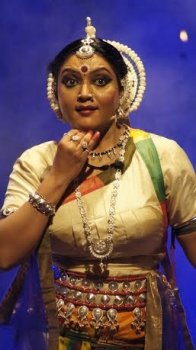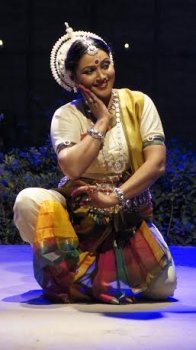 |
|
 |
|
When a poem dances... - Shveta Arora e-mail: shwetananoop@gmail.com Photos: Anoop Arora April 18, 2014  On the 21st of March, Sahitya Akademi and the Ministry of Culture
organized an Odissi recital by Kavita Dwibedi at the Meghdoot Theatre
Complex in Delhi as part of Sabad – A World Poetry Festival. It was an
amazing venue, all done up with huge cane urns and vessels and wooden
figurines. The open air stage was constructed around a huge tree. There
were two huge sculptures of dancers on the stage. The leaves and flowers
kept falling from the tree. The koel was cooing with the most melodious
notes and squirrels were running up and down the tree trunk. The
pleasant evening was accentuated by soft music and diyas shimmering in
the background. On the 21st of March, Sahitya Akademi and the Ministry of Culture
organized an Odissi recital by Kavita Dwibedi at the Meghdoot Theatre
Complex in Delhi as part of Sabad – A World Poetry Festival. It was an
amazing venue, all done up with huge cane urns and vessels and wooden
figurines. The open air stage was constructed around a huge tree. There
were two huge sculptures of dancers on the stage. The leaves and flowers
kept falling from the tree. The koel was cooing with the most melodious
notes and squirrels were running up and down the tree trunk. The
pleasant evening was accentuated by soft music and diyas shimmering in
the background.Kavita is the daughter and disciple of Odissi maestro, the late Guru Hare Krishna Behera. She has performed widely in India and abroad. The recipient of many awards, she is the founder director of Odissi Akademi, Delhi. She has been awarded the Odisha State Sangeet Natak Akademi Award for the year 2013. The production was a collaboration of Odissi dancer Kavita, Odia poet Kedar Mishra, and Odissi musicologist Guru Ram Hari Das. Besides that, poems by great writers like Amrita Pritam, Maithali Sharan Gupt and Rabindranath Tagore were taken as connecting themes. The title ‘Shweta Mukti’ probably refers to the liberation of the white dove from the shackles of the world. Kavita said that they chose that title because white represents purity and the shwet padam or the white lotus is the symbol of the Buddha. In the entire composition, there was no direct reference to the Buddha, who was being addressed as the shwet kapot or the white dove. It is only in the last sequence that Buddha is shown as a reflection on the tree, which Kavita said reminded her of the bodhi tree. The ambience of the place dispelled all her apprehensions of performing in an open space. The production was about the story of five women, divided into five short episodes, each one of them associated with Buddha in her own story and each one being dazzled with self-realization in her own way. They are all different, but they share with each other a longing for mukti. For each woman, Kavita chose a colour for the angavastram or the odhni, and the manner in which it was worn. The first woman to be depicted was Gautami. She nurtured him in his childhood as a mother and subsequently became his disciple. Buddha was her foster son and guru. The poetry talks about a wet night with strong winds and strange sounds. Gautami talks about the omens foretelling that Buddha would be going away. Kavita wore a yellow angavastram as the queen mother. Her portrayal showed instances between the mother and the son during Buddha’s childhood. She playfully chides him for venturing out and plays with him while they share the pleasure of looking at the birds and the deer. She lovingly calls him her flower, her punya, her pavitra (pure). She puts a tilak on his forehead, a black spot with khol to save him from the bad elements. Tora sneh, mora jivan nayantara (your love is my life). She is dazzled by the brightness of her son’s presence as he heads for the nirvana path. As he leaves the house, she fares him well. Portraying the emotions of a mother being protective and playful, saddened and yet resigned, Kavita’s eyes welled with the emotions.  Yashodhara, the beautiful and dedicated wife of Buddha, was depicted
next. She loved him immensely, but she knew that she could not contain
the spirit of her lover, whose incarnation was meant for the whole world
and not just for her. Yashodhara dedicates her total being at the lotus
feet of her husband. The poetry recitation reads: The sky beckons the
white dove of peace. She asks the enlightened one to show her the path
to mukti. Aaj adhik veh bhate, veh mujhse keh kar jaate (he
should have told me his intentions of leaving). The abhinaya portrayed
the season of love, with lotuses blooming in ponds and birds chirping.
Yashodhara beautifies her chamber by tying a toran on the door and
sprinkles fragrance on her bed. She is getting ready to meet her
husband, wearing ornaments and tying her hair. Shyly, she welcomes him
and begins to press his feet. Suddenly, he gets up to go. He is
determined to abandon his worldly pleasures and seek divinity.
Yashodhara is left in misery; she too gives up the world – symbolically,
by removing her ornaments - to seek the jyoti mukti path, addressing him as the shwet kapot. Kavita displayed Yashodhara’s love and then pain, followed by misery and finally determination and peace. Yashodhara, the beautiful and dedicated wife of Buddha, was depicted
next. She loved him immensely, but she knew that she could not contain
the spirit of her lover, whose incarnation was meant for the whole world
and not just for her. Yashodhara dedicates her total being at the lotus
feet of her husband. The poetry recitation reads: The sky beckons the
white dove of peace. She asks the enlightened one to show her the path
to mukti. Aaj adhik veh bhate, veh mujhse keh kar jaate (he
should have told me his intentions of leaving). The abhinaya portrayed
the season of love, with lotuses blooming in ponds and birds chirping.
Yashodhara beautifies her chamber by tying a toran on the door and
sprinkles fragrance on her bed. She is getting ready to meet her
husband, wearing ornaments and tying her hair. Shyly, she welcomes him
and begins to press his feet. Suddenly, he gets up to go. He is
determined to abandon his worldly pleasures and seek divinity.
Yashodhara is left in misery; she too gives up the world – symbolically,
by removing her ornaments - to seek the jyoti mukti path, addressing him as the shwet kapot. Kavita displayed Yashodhara’s love and then pain, followed by misery and finally determination and peace.The next piece was about Magandhi, the beautiful Brahmin girl who loved Buddha with immense passion, but when spurned by him, became his arch rival and challenged him. Kavita wore a red angavastram for this sequence. Magandhi was possessive about Buddha, but when she could not attain him, she hatched a conspiracy to annihilate him. In the process, she had her moment of enlightenment. Kavita’s gait, attitude and eye expressions, all depicted arrogance or ahamkar. She says, tume mora, tume priya (you are mine), tume shatru (my enemy). She takes a vajra shapath, a vow like a weapon, to destroy him. In her moment of realization, she wishes the white dove to fly away. The abhinaya transformed from emotions of love and possession to hatred and then remorse. The following story was that of Amrapali, the wealthy courtesan of Vaishali, who was charmed by Buddha. Kavita wore a purple odhni like a dancer’s. Amrapali possesses all the material wealth, but deep down, she feels emptiness - shunyata. The longing for someone becomes her life. She dances in the court but is waiting to hear him come. When she sees Buddha, she feels that attraction or akarshan. She sees him as the mukti surja or the sun of liberation. Tume satya, tume tap, priyavrat priya kapot – you are the truth, you are penance, oh, my dear white dove. The emotions portrayed in this segment were of emptiness, longing, wonder and enlightenment. Finally, Kavita depicted the story of Prakruti. What she wore now was a simple odhni, like a commoner. Prakruti belonged to a downtrodden family; Buddha liberated her from the shackles of caste and she followed him in his path. She was the first woman ambassador of equality and liberty in Buddha’s sangha. She was a chandalani, a lower caste woman, whose life was a lanchhan or a blot. While she is drawing water from the well, Buddha appears and asks her for water. She asks him to go away, for she is an untouchable. Buddha enlightens her, gives her an identity and fulfils her longing for salvation. A shadow of Buddha appeared on the tree with the chanting of Buddham sharanam gachhami and Prakruti prostrates herself before it. Kavita’s emotions move from humility and fear to the final fulfillment. The credits for this interesting presentation include: Concept and choreography by Kavita Dwibedi, Odiya poetry by Kedar Mishra, music composition by Guru Ram Hari Das assisted by Guru K Rama Rao Patra, rhythm composition by Guru Dhaneshwar Swain and light design by Sandeep Datta. Shveta Arora is a blogger based in Delhi. She writes about cultural events in the capital. |